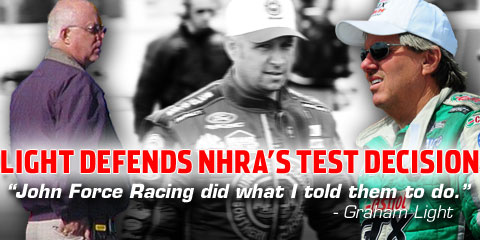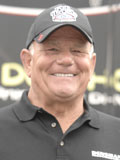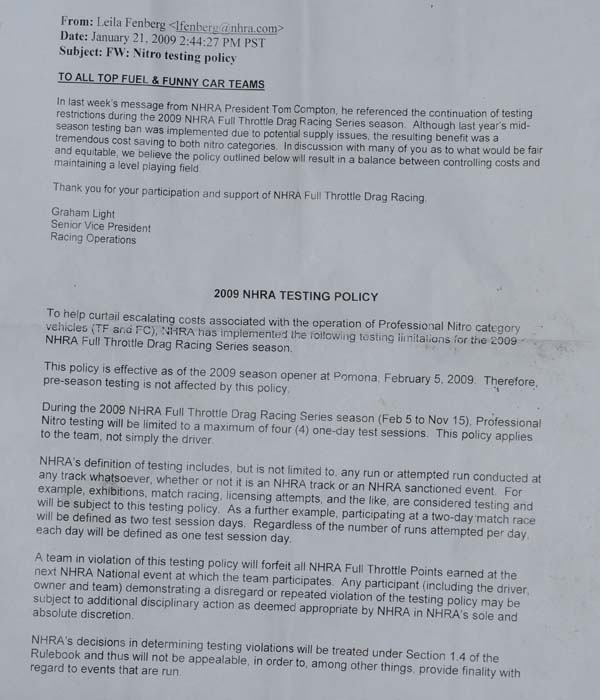LIGHT DEFENDS TEST DECISION
 President of Operations during a break in the action in the Toyo Tires Nationals at Maple Grove Raceway Saturday afternoon. “I think it's unfair for anyone to be critical of John Force.”
President of Operations during a break in the action in the Toyo Tires Nationals at Maple Grove Raceway Saturday afternoon. “I think it's unfair for anyone to be critical of John Force.”Light has already accepted the criticism for a mistake made on January 21, 2009 which led to the confusion coming out of events on August 17th at Brainerd Int'l Raceway.
The error, a changing of words, should have been caught in January. It wasn't. Not by Light or any others responsible for ensuring press releases concerning policy decisions are accurate. Those facts change nothing. They don't change the intent of the testing policy applied to Top Fuel and Funny Car teams by the NHRA and how it has been applied, according to Light.
“Spin it any way you want, the bottom line is John Force Racing “did exactly what I told them to do”, said  Graham Light, NHRA Vice President of Operations during a break in the action in the Toyo Tires Nationals at Maple Grove Raceway Saturday afternoon. “I think it's unfair for anyone to be critical of John Force.”
Graham Light, NHRA Vice President of Operations during a break in the action in the Toyo Tires Nationals at Maple Grove Raceway Saturday afternoon. “I think it's unfair for anyone to be critical of John Force.”
Light has already accepted the criticism for a mistake made on January 21, 2009 which led to the confusion coming out of events on August 17th at Brainerd Int'l Raceway.
The error, a changing of words, should have been caught in January. It wasn't. Not by Light or any others responsible for ensuring press releases concerning policy decisions are accurate. Those facts change nothing. They don't change the intent of the testing policy applied to Top Fuel and Funny Car teams by the NHRA and how it has been applied, according to Light.
The intent of the testing rule according to Light was basically, “to protect the big dollar teams from themselves”.
Most of the multi-car operations had taken to testing almost every Monday after an event. Force was testing. Schumacher was testing. The heavily funded teams were all testing and spending huge dollars in the process. Until the Hight test at Brainerd, the rule was working just fine. Then the question became, how could Hight be allowed to test for a fifth time when the policy clearly stated only four tests would be allowed without penalty.

 Terry Haddock looked over the document in his hands and shook his head. He read deeper and shook his head even more.
Terry Haddock looked over the document in his hands and shook his head. He read deeper and shook his head even more.“I have never seen this,” said Haddock. “And, this is not the way the policy was explained to me.”
The document - a print out of an email sent from Graham Light's assistant to car owners, drivers and crew chiefs participating in the NHRA.
Haddock looked over a second document and shook his head again. The document, two pages from the 'NHRA Competition Policies & Procedures Manual – 2009 Professional Edition' which was assembled by Graham Light, NHRA Vice President of Competition and sent to PRO (Professional Racers Organization).
“PRO wants $2000 to be a member and that's not in my budget,” said Haddock.
Haddock has been steadfast in his assertion that he went to Light after reading the press release on the test policy and told him he was committed to running the first two IHRA events of the 2009 season and a match race in Edmonton. At the time, there was no issue. Haddock says Light told him running the two events would put him over the testing limit.
Haddock claims he offered up the possibility he could drive for another team at the IHRA events, but was told he would still be over the limit. If the interpretation of the testing policy was the same then as it is now, Haddock says he would have accepted an offer from Doc Sipple to drive his dragster in the first two IHRA events.
With the water already under the bridge, Haddock is left to play a game of 'what if'; what if he had driven for another car owner in those IHRA events. Haddock, currently is not even close to getting into the Countdown to 1, but he believes he could be close had he had better information available to him earlier in the season.
Sitting next to Gary Densham, Haddock just kept shaking his head at what he believes might have been. It's a big “what if” and he knows it.
Densham believes the NHRA could improve on the testing rule and clear up any ambiguity if they would switch from “test days” to “test runs”.
“Let us make X number of test runs, the team, the driver, it just doesn't matter. You get X number of test runs, even if its a run in a match race or an event with another sanctioning body. That's what you get and that's it,” said Densham.
“I believe the confusion came about because of the way we worded the press release,” said Light. “On January 21st my assistant emailed the testing policy to the car owners, drivers and crew chiefs. On that same day a release was issued to the press. They didn't read the same.”
Light also put together a complete manual titled 'NHRA Competition Policies and Procedures Manual, 2009 Professional Edition' and sent it to PRO, the organization of drivers and car owners on the NHRA circuit. The manual was sent out approximately three months after the testing policy email, according to Light.
Light explained that the testing policy issued to the owners, drivers and crew chiefs didn't include the spice and fluff that typically finds it’s way into a press release. And, when the policy was reduced to a press release there was a change which had a definite effect on the meaning of the policy.
A line in the press release reads, “This policy applies to both the team and driver.”
The policy states, “This policy applied to the team, not simply the driver.”
Light explained the word “driver” was included in the policy because the NHRA does not award points to teams; they award points to drivers. If a team violates a policy or rule, and the penalty involves a reduction in points then it is the driver who is penalized.
According to Light, it was never the intention of the rule to put an unfair burden on the lesser teams, “the policy was designed for the big money teams, not the (smaller teams).” However, to prevent the bigger organizations from exploiting the IHRA the policy was written so that runs made in IHRA events and other specialty events, like Norwalk's Night of Fire, would count as test days.
The intention was never to deter drivers and teams in the IHRA from entering NHRA events, which is why the penalty was limited to points and didn't involve money.
“We welcome the IHRA guys,” said Light. “We don't want to hurt the IHRA guys. That is why there is no monetary penalty.”
According to Light, a situation exists in which a driver could run in IHRA events without penalty. If a driver runs in both series but does so with completely different equipment, different chassis and a different crew chief, Light agreed there would be no reason for a penalty. He also pointed out that such a situation would require constant supervision from the sanctioning body to ensure crew chiefs or crew members from one side were not working on the other side, as well.
What the NHRA doesn't want is the big money teams using the IHRA, or even the NHRA, to run satellite teams that have no purpose other than to test parts and pieces.
In Light's eyes, when John Force's people came to him around the time of the Norwalk Night of Fire offering up different scenarios and asking how each would be viewed by the sanctioning body, he thought about the intent of the policy and gave his blessing to Hight testing Force's Funny Car. When Force came to him again at Brainerd to ensure Light had not changed his mind Light says he told Force, “If Prock is not there, I don't care.”
Light is genuinely concerned about the confusion caused by the difference in wording between the press release and the policy statement.
“This is the first year of this rule and we tried to write it clearly, black and white. Our intent was to save money and not to injure smaller teams. We know we need the smaller operations the same as the sport needs the bigger teams.”
In the mind of the NHRA, they have the best drivers in drag racing participating at their events and testing isn't typically about improving the performance of the driver; it's about improving the performance of the car. Force racing wasn't trying to make Robert Hight a better driver and the No. 7 Castrol car had two tests left before Brainerd. Now they have one left. End of story.

The email send to membership on January 21 (top). Below is a copy of the policy included in a policy book provided to PRO sometime after March of this year.

Advertisement



































